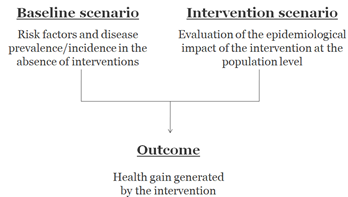7.1. Overview¶
At a high-level, the SPHeP-NCD model is designed to model the population health outcomes (up until 2050 by country or region) by comparing outputs across scenarios.
More specifically, actions are evaluated against a ‘business-as-usual’ scenario (i.e. baseline scenario) in which no new policy is put in place and provision of preventive and healthcare services is implemented at the current levels, specific to a country (Fig. 7.1). The comparison between the ‘business-as-usual’ and the policy scenario corresponds to the impact of a policy, and it is carried out by considering all the relevant dimensions including, for instance, differences in health, healthcare costs, labour market productivity and so on, which provides all the needed information to carry out a return of investment analysis.
For example, the model is designed to answer, what are the health gains of reducing alcohol consumption by X grams per day?
Further details are provided in subsequent sections.

Fig. 7.1 SPHeP-NCD General Principles¶
